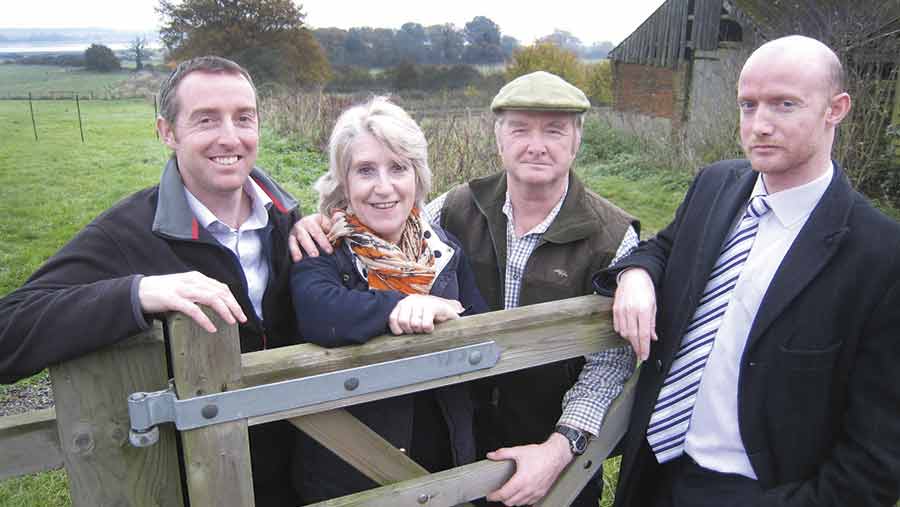Maintaining sea walls on farmland – legal issues to know about
Sea wall maintenance is often left to landowners but can be a minefield of red tape. Navigating the legal issues is essential, however, before starting any work – no matter how urgent.
Farmers and landowners have no obligations in relation to the sea wall generally, but the Environment Agency (EA) is not obliged to maintain these walls either. It simply has the authority to carry out works, when funding allows.

© FLPA/Rex/Shutterstock
It therefore falls to the farmer to maintain the wall or lose vast swathes of land, and potentially expose residential or commercial properties to flooding and walkers to danger.
As a result, landowners can and do face costly enforcement action, even prosecution, for failing to use the right materials to mend sea walls, particularly if acreage falls into environmentally sensitive areas.
 Mark Wrinch, associate solicitor, Birkett Long
Mark Wrinch, associate solicitor, Birkett LongIn order to carry out works to protect land, the farmer must apply for an exemption permission from the EA.
There is no specific exemption related to sea walls; instead there are 93 possible exemptions covering all manner of works such as waste disposal.
These are all on the EA website but to navigate through and find the ones you need, it is best to contact the EA and ask them to help work out what is needed. Each licence costs £1,600 upwards.
Many coastal areas however cover Environmentally Sensitive Areas (ESA), Special Scientific Interest (SSI), Areas of Outstanding Natural Beauty (AOB) and other such environmental and wildlife designations, which require bespoke exemptions from the EA.
These tend to cost considerably more – the sum being dependent on what is needed – and Natural England and other wildlife groups will also need consulting.
Get licences in place before carrying out work
Getting the necessary permissions from the EA, particularly bespoke licences, can be protracted and take several months, so consult with them early and take professional advice.
The EA is in the process of developing an exemption for small scale works that should hopefully help with cutting through the red tape, but this is not ready yet. There are however a few local groups being set up to help farmers navigate the current process.
Do not under any circumstance undertake works without the necessary permissions, as you could face environmental enforcement, possibly even prosecution and fines or even prison sentences in the worst scenarios.
Be aware that exemption permissions are licensed to individuals, not properties, so if a coastal farm is changing hands, the new occupier will have to apply for their own licence. On tenanted land, whoever carries out the sea wall maintenance – landlord or tenant – must hold the licence.
Check contractors and materials
The EA employs environmental engineers who should be able to advise on the type of work and materials that are needed. Always get this advice before planning work.
If the work requires contractors and suppliers, ask the EA to check they have the necessary permissions, such as for waste disposal, and have a clean track record. Local word of mouth should be a good indication, too.
Always assess the quality of materials that arrive on site and collect waste tickets for each and every load – the materials must match description, be inert and, in an ideal world, clay.
Case study: £27,000 spent to protect 112 acres

The Wrinch family, Richard and Hazel Wrinch (centre) with their sons Mark (right) and James (left)
Suffolk farmer Richard Wrinch has had to part with £27,000 in the past three years for repairs to his one-and-a-half-mile stretch of sea wall.
“We had been told by the Environment Agency before the tidal surge of December 2013 that it had withdrawn maintenance of our wall and repairs were up to us,” said Mr Wrinch.
“The wall didn’t disappear but it was overtopped and after five weeks of waiting for the water to vanish we realised it had taken 90% of the clay shoring it up.”
It cost the Wrinch family £17,000 to hire experts and buy the heavy plant to reclaim the clay following the tidal surge. In the autumn of 2015 it had to make another repair to a 40m stretch of wall at a cost of £10,000.
If they had done nothing, the sea would eventually have reclaim about 112 acres of their land.
“Managed retreat might be our only way in the future because maintaining all 1.5 miles in the long term is not viable,” said Mr Wrinch.
The family received support from the Essex Coast Organisation (ECO), set up by farmers to examine and challenge the withdrawal of sea-wall maintenance by the EA.
ECO has developed a good working relationship with the regional EA representative and the agency’s Anglian Regional Flood and Coastal Committee has now committed an annual £19,500 to provide materials, labour and plant costs for small-scale maintenance works.
Andrew St Joseph, farmer and head of ECO, said: “By intervening early, repairs stay small, allowing the EA to focus its reduced resources on more complex repairs.
“Years ago it would take two months and a written application to acquire permission. Now, with increasing trust between us and the local EA representative, it requires just a telephone call for small-scale works.”
